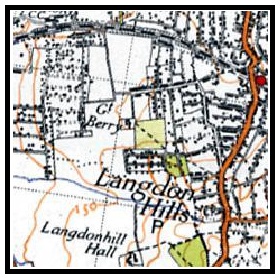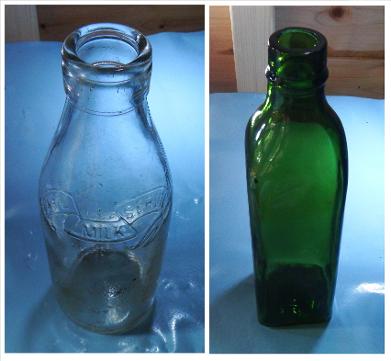

Langdon Hills and Lince Wood circa 1940s. This is the 1: 63, 360 OS map.The approximate area of study by the pupils of Lincewood Primary School is within the red circle. The present-day school is located at the red dot. The green shaded woodland to the west of the school is Lince Wood, and as can be seen is one of the few areas of woodland remaining throughout this period. It is within the wood/school site that much of our study has been done. It must be remembered that the whole of the settlement in this area was 'unplanned'. People built largely where they wanted to. The former Corona Road ran through the current Lincewood Primary School site. The present day Corona Road has been rebuilt somewhat to the south of its old course. See map Page 1. The school site was a plotlands site.

ABOVE LEFT: a collection of shards of pottery, porcelain, and earthenware found on our plotlands site dating from the late 19th century (item just below left of centre 'dirty' cream with some blue design) to the 1960s. In all we found 25 coloured and designed-pieces; a few later ones found are not included here. ABOVE RIGHT : 'Safe Milk Service' glass milk bottle from the 1950's and a green glass bottle of unknown origin/use.
ABOVE LEFT: Just a few of the 75 shards of white pottery, porcelain, and earthenware found. The isolated piece in the extreme top right of the picture tells its own, early, story : it is 'Pyrex'....the first sign we have from what we think is a late 1950's / early 1960's site of heat resistant white glassware. ABOVE RIGHT: the first thing we found: it all started with this! and got the pupils very excited - an enamel plate. It is quite amazing that it has lasted in the ground all these years. Thus it's a special artefact for us.
ABOVE LEFT: A miscellaneous collection of artefacts found at our site: by far and away the heaviest was the pick-axe head, rusted but could still work! Along with the earthenware shards, we have remains of roofing tiles, flower pots, a 'Roses' marmalade jar (enlarged right), an oven tray, a field marker stake (one of the original plotland ones?) and a purple glass candle holder. ....as well as previously shown milk bottle, and green-glass bottle.
LEFT: The original piece of 'ironstone' china found on the plotlands site by the author. This is probably part of the base of a plate. It was made by the company J & G Meakin - part of the 'SOL' pattern, and dates from between 1918 and 1963. Their factory was in Hanley in Stoke-on-Trent. This is the era when the plotlanders were at their greatest number across Langdon Hills and Laindon. There is some evidence that this piece may be 1920's or 1930's. Ironstone china was very strong, didn't chip easily, and was glazed. It was quite cheap, and made in huge amounts.